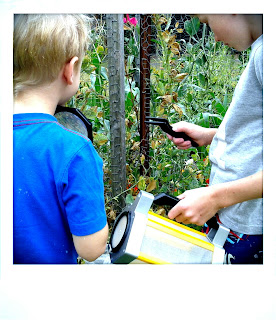It is a group of mainly older folk who have some fruit trees and raised garden beds beside a retirement home. From what I could gather, they are encouraging individuals and groups to have a 'plot' and pay a small annual fee. They can plant whatever they like and join in a monthly gardening meeting.
Roping in a friend to share the experience, I got to mingle with a dietician, the stay at home mum guru, the 'bee man', uni students and a few other folk who I think lost their way back to the retirement home… plus share in a delicious vegetarian lunch with fresh seasonal produce complete with damper and home-made pestos. Oliver and his friend did some 'craft' and there was even some awesome live music from a very talented local guitarist. I taste tested honey from local native bees (yuck - give me honey bees honey any day), then there was a 'op shop' fashion parade… All the ingredients for a great day out - If only there were more people.
Now I get to have my little 'dig' at that lack of support these 'community' events have. Makes you want to sell up and move to Nimbin! Come on folks - get out there and get involved! Attend open days, make new friends and support these initiatives! Nothing to lose but so much to gain…

.jpg)









